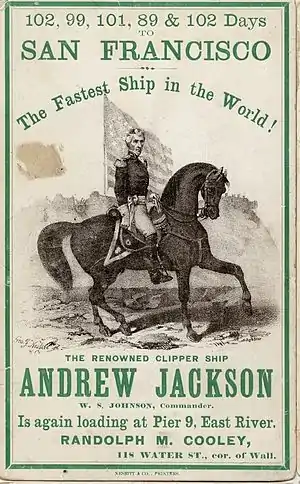Andrew Jackson (clipper)
The sailing ship Andrew Jackson, a 1,679-registered-ton medium clipper, was built by the firm of Irons & Grinnell in Mystic, Connecticut in 1855. The vessel was designed for the shipping firm of J.H. Brower & Co. to carry cargo intended for sale to participants in the California Gold Rush.
 Advertising card for Andrew Jackson | |
| History | |
|---|---|
| Name: | Belle Hoxie |
| Builder: | Irons & Grinnell, Mystic, Connecticut |
| Launched: | March 1855 |
| Renamed: | Andrew Jackson |
| Owner: | John H. Brower & Company |
| Fate: | Sold to British owners, 1863 |
| Owner: | H. L. Seligman, Glasgow (in 1868) |
| Acquired: | By British owners, 1863 |
| Fate: | Wrecked 4 December 1868 |
| General characteristics | |
| Class and type: | Medium clipper |
| Tons burthen: | 1679 tons OM |
| Length: | 220 ft (67 m). |
| Beam: | 41 ft 2 in (12.55 m) |
| Draft: | 22 ft (6.7 m). 3 in.[1] |
Construction
The ship's dimensions were: length 220 feet (67 m), beam 41 ft., 2 in., and draft 22 ft., 3 in.[1] The vessel was described as "a very handsome, well-designed ship. She was heavily sparred and carried double topsails, skysails, and royal studdingsails."[2]
Voyages
Andrew Jackson made seven passages from New York to San Francisco, with an average time of 1061⁄3 days. These times compare well with the passages of extreme clippers such as Flying Cloud and Flying Fish, which averaged 1055⁄7 days and 1031⁄3 days respectively,[1] and the vessel was advertised as "The Fastest Ship in the World."[3]
Record passage to San Francisco
Andrew Jackson is best known for her 1859–1860 run around Cape Horn from New York City to San Francisco, which the vessel performed in 89 days and 4 hours. The run began at noon on Christmas Day, 1859, and ended at 4 p.m. on 23 March 1860 at the Farallon Islands.[4]
This was one of only three 89-day runs performed by square-rigged ships driving from New York City to California. The other two runs were both posted by Flying Cloud. Flying Cloud's fastest New York-to-California run had taken 89 days and 8 hours; Andrew Jackson's run was, by four hours, widely acclaimed in the newspapers as the fastest in history.[4]
Andrew Jackson's run, as calculated above, was from New York City to the Farallon Islands, the pilot boat entry point to the harbor of San Francisco. Andrew Jackson did not get a pilot boat in a timely manner and did not actually tie up at a San Francisco wharf until the next day.[4] Some clipper ship authorities, including Howe and Matthews, assert that Andrew Jackson did not actually set the record described above. They concede, however, that this medium clipper, perhaps not naturally as fast as Flying Cloud, achieved a remarkable passage as the result of a combination of hard driving by the captain and favorable winds.[1]
Andrew Jackson vs. Flying Cloud
However, after careful scrutiny of the logbooks, one author, Carl C. Cutler, concludes that a case can be made for either Flying Cloud or Andrew Jackson holding the record. Some will consider the passage from pilot-to-pilot as the appropriate indicator of fastest sailing performance around Cape Horn. Flying Cloud holds the record time for a passage anchor-to-anchor from New York to San Francisco, of 89 days 8 hours, while Andrew Jackson's completed passage anchor-to-anchor may have been as long as 89 days 20 hours.[5]
Loss
Andrew Jackson was lost on December 4, 1868, after going ashore on a reef in the Gaspar Strait.[1]
Legacy
Andrew Jackson's 1859–1860 run was to be one of the final sailing-ship records posted by an American clipper ship. During the 1860s, the progress of colonialism led to the creation of a network of coaling stations worldwide to serve fast steamships with a reliable supply of fuel, and the market for clipper-ship freight collapsed.
Images
- Painting of clipper ship Andrew Jackson, Mystic Seaport Museum
- Painting by Percy Sanborn, Clipper Ship Andrew Jackson, sold in 2012.
See also
References
- Howe, Octavius T; Matthews, Frederick C. (1986) [First published 1926–1927]. American Clipper Ships 1833–1858. Volume 1, Adelaide-Lotus. New York: Dover Publications. pp. 7–9. ISBN 978-0-486-25115-8.
-
Clark, Arthur H. (1910). The Clipper Ship Era. G.P. Putnam's Sons. p. 295. OCLC 7530341.
clipper ship era 1910.
- Lyon, Jane (1962). Clipper Ships and Captains. American Heritage Publishing Co. p. 121. OCLC 248617.
- Lyon, Jane (1962). Clipper Ships and Captains. American Heritage Publishing Co. p. 132. OCLC 248617.
- Cutler, Carl C. (1960). Greyhounds of the Sea. Annapolis, MD: United States Naval Institute. pp. 360–368. OCLC 569193.